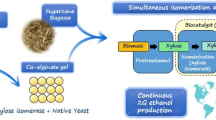Abstract
The optimum temperature operation mode required to achieve high fructose productivity is studied for immobilized glucose isomerase (GI) packed bed reactor. In this study, the reactor design equation based on reversible Michaelis-Menten kinetics assumes both thermal enzyme deactivation and substrate protection. The optimization problem is formulated as a discretized constrained nonlinear programming problem (NLP). The formulation is expressed in terms of maximization of fructose productivity as the objective function subject to reactor design equation, kinetic parameter equations, substrate protection factor equation and feasibility constraints. The constraints are discretized along the reactor operating period by employing piecewise polynomial approximations. Approximately 7% improvement in terms of fructose productivity is achieved when running the reactor at the optimum decreasing temperature operation mode as compared to the constant optimum isothermal operation.
Similar content being viewed by others
Author information
Authors and Affiliations
Additional information
Received: 7 July 1997
Rights and permissions
About this article
Cite this article
Faqir, N. Optimization of glucose isomerase reactor: optimum operating temperature mode. Bioprocess Engineering 18, 389–396 (1998). https://doi.org/10.1007/s004490050461
Issue Date:
DOI: https://doi.org/10.1007/s004490050461




